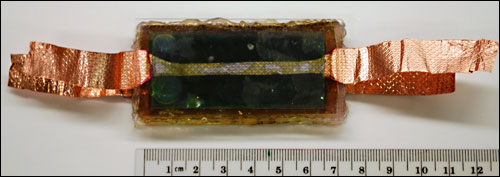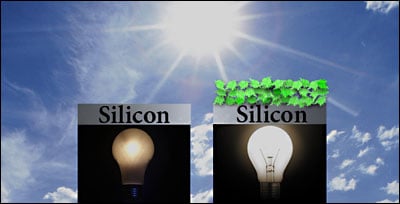
Spinach Power Boosts Si Solar Cells
Popeye's not the only one who can get a big power boost from spinach: Combining the vegetable's photosynthetic protein with silicon produces significantly higher current levels than can be achieved by other such "biohybrid" cells composed of the plant protein and metal.
"This combination produces current levels almost 1000 times higher than we were able to achieve by depositing the protein on various types of metals. It also produces a modest increase in voltage," said David Cliffel, Vanderbilt University associate professor of chemistry, who collaborated on the project with Kane Jennings, professor of chemical and biomolecular engineering. "If we can continue on our current trajectory of increasing voltage and current levels, we could reach the range of mature solar conversion technologies in three years."

A biohybrid solar cell based on a previous design was built by Vanderbilt students using the photosynthetic protein from spinach. (Photo: Amrutur Anilkumar, Vanderbilt University)
Scientists have known for more than 40 years that one of the proteins key to photosynthesis, called Photosystem 1 (PS1), continues to function after it is extracted from plants such as spinach. They have determined that PS1 converts sunlight into electrical energy with nearly 100 percent efficiency, compared with conversion efficiencies of less than 40 percent achieved by man-made devices. This has prompted research groups around the world to use PS1 to create more efficient solar cells.
The Vanderbilt team pursued silicon because it is cheap and readily available. The researchers made their device by extracting PS1 from spinach into a water-based solution, and poured it onto the surface of a p-doped silicon wafer. Putting the wafer in a vacuum chamber evaporated the water, leaving behind a film of protein on the silicon. They found that the optimum thickness was about 1 µm, or about 100 PS1 molecules thick.
The random orientation of the individual proteins on the metal layer was a major problem in previous modeling work, they said, because the electrons produce both positive and negative currents that cancel each other out and leave a very small net current flow. In a leaf, all the PS1 proteins are aligned, leading to a uniform, positive charge. Using p-doped silicon eliminates the problem in the man-made material.
“This isn’t as good as protein alignment, but it is much better than what we had before,” Jennings said.
The team reports that its PS1-silicon combination produces nearly a milliamp (850 microamps) of current per square centimeter at 0.3 volts. That is nearly two and one-half times more current than the best level reported previously from a biohybrid cell. Vanderbilt has applied for a patent on the protein-silicon combination.
Since the initial discovery, progress has been slow but steady. However, the amount of power that these biohybrid cells can produce per square inch has been substantially below that of commercial photovoltaic cells. Another problem has been longevity: The performance of some early test cells deteriorated after only a few weeks.

Vanderbilt researchers combined the photosynthetic protein from spinach with silicon in a way that produces substantially more current than previous biohybrid solar cells. (Image: Julie Turner, Vanderbilt University)
In 2010, however, the Vanderbilt team kept a PS1 cell working for nine months with no deterioration in performance.
"Nature knows how to do this extremely well. In evergreen trees, for example, PS1 lasts for years," Cliffel said. "We just have to figure out how to do it ourselves."
The team's next step is to build a functioning PS1-silicon solar cell using this new design. A group of undergraduate engineering students will build the prototype using an Environmental Protection Agency award that Jennings received.
With the new design, Jennings estimates that a 2-foot panel could put out at least 100 milliamps at one volt – enough to power various types of small electrical devices.
Most plants use the same photosynthetic proteins as spinach; Jennings also is working on a method for extracting PS1 from kudzu.
Graduate students Gabriel LeBlanc, Gongping Chen and Evan Gizzie contributed to the study. The research was reported online Sept. 4 in Advanced Materials.
For more information, visit: www.vanderbilt.edu
Published: September 2012